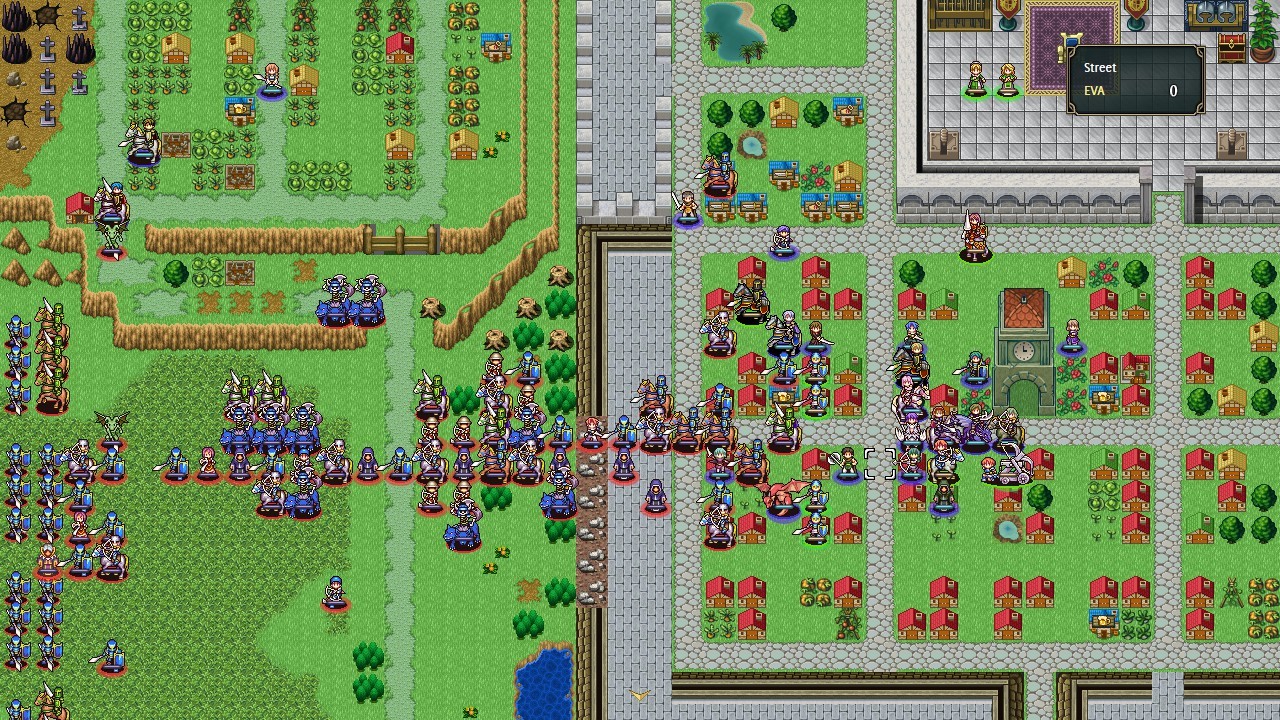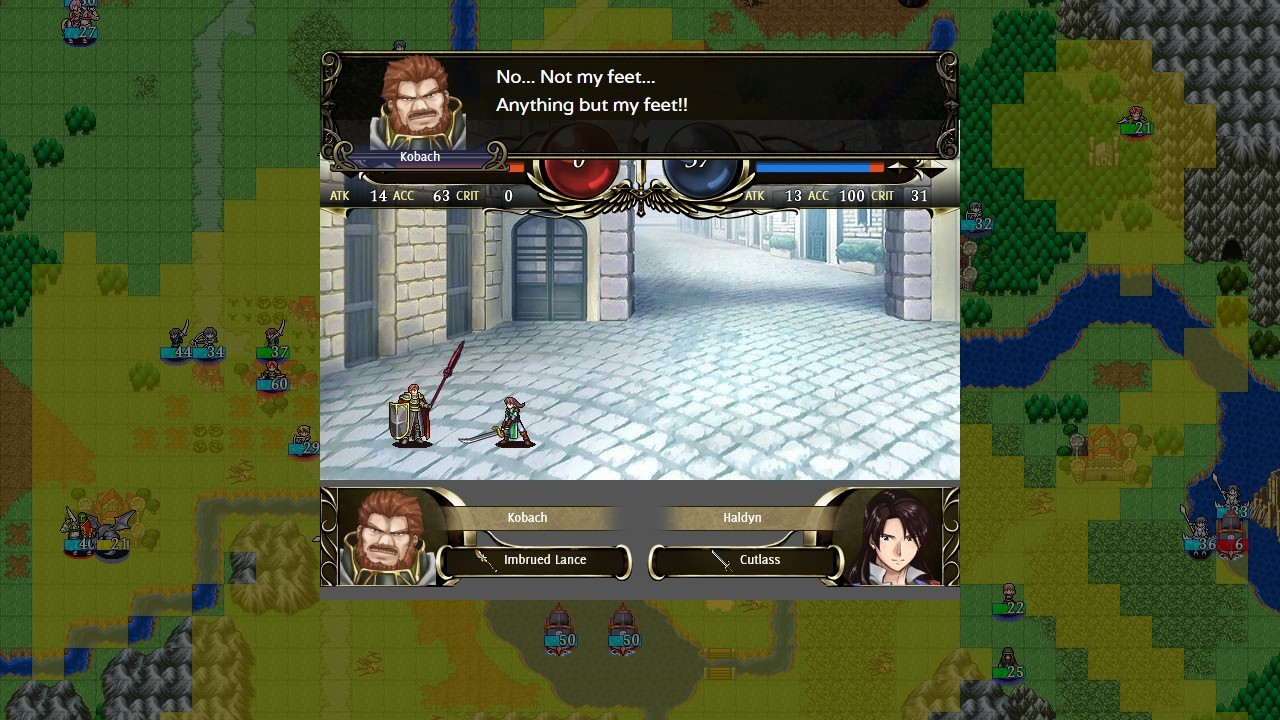Got the itch for more Fire Emblem? Vestaria Saga is the project of Shouzou Kaga, the creator of the original game in Nintendo’s flagship strategy RPG series. War of the Scions was the first part of this planned trilogy, and we now have the official second part: Vestaria Saga II: The Sacred Sword of Silvanister. Fire Emblem fans will find a game that feels familiar but different as Kaga has added some new twists to the formula for those up to the challenge.
Vestaria Saga II follows the continuing story of young military prodigy Zade (short for Zadrian), who is on another adventure after upending the Solvian Empire in part one. Now, he’s had a falling out with his brother, Zech (short for Zecharias), a fellow military commander, and Zade strikes out on his own, looking for someone to help with his sword. Unfortunately, while the story is set up as a sweeping quest of political intrigue and personal conflict, the main narrative loses its way almost immediately. What, at first glance, starts as a classic tale of sibling rivalry takes an abrupt turn into something less compelling and coherent. The overall plot melts into a jumble of names, places, and groups of people you’ll never cross. You also fight many antagonists with little setup or foreshadowing and generally spend too much time far away from Zade’s main conflict, which also becomes hazy. While playing Vestaria Saga I may benefit players new to the series, you won’t miss anything vital by starting with Vestaria Saga II.
In terms of gameplay, Vestaria Saga II continues in the comfortable footsteps of the Fire Emblem series. Fans of those games will instantly feel at home on the grid-based maps, moving and attacking with their characters one at a time before the enemy takes its turn. But those who have played either of the Switch Fire Emblem games will find that Vestaria Saga II kicks those concepts into overdrive, feeling much more like the complex, tougher 3DS Fire Emblem entries.
As a direct continuation of the previous game’s story, it wouldn’t make sense for the characters to revert to being lower-level classes in Vestaria Saga II. Sure enough, their stats are higher and their abilities more advanced, giving you the power to take on the bigger and badder enemies you encounter. In many strategy games, you can rely heavily on one character, but Zade isn’t godlike. Though he’s formidable, he’s also fragile, meaning you have to rely more on his supporting cast. There are also some added wrinkles to the gameplay that weren’t in the first game, like the ability to recruit some enemies to your ranks and a greater variety of objectives during missions. Your goals are never to annihilate everything that moves, as they tend to be in Fire Emblem games, which is refreshing. In one mission, you’re evacuating villages from an incoming enemy threat, and in the next, you conduct a sneaky operation to rescue a member of your crew who has been captured. On the other hand, recruiting feels underdeveloped and underused.
Vestaria Saga II’s maps are immediately overwhelming in size and scope, like an entire region of an RPG zoomed out, with sweeping fields, mountains, towns, and litters of enemies. Each level feels like its own ecosystem, with friendly characters going about their business until enemies attack them. There’s a surprising feeling of adventure as you move your little people around and consider whether it’s safe and in line with your mission goals to investigate that castle or volcano on the other side of the map.
While Vestaria Saga II’s main narrative is incomprehensible, stories of the dozens of individual characters on your roster lent the emotional heft to keep me engaged. Seeing even the seemingly rote and insignificant characters get attention with their own thoughtful arcs is fun. One set of brothers are at odds with each other over something that happened long ago, and a pair of pirates pontificate on whether a pirate’s life is still for them. Zade is fine as a main character, though he’s little more than a typical wunderkind. He has such a propensity for helping anybody who asks, no matter how inconvenient the task may be for him and his crew, that other characters constantly acknowledge and razz him for his goody-two-shoes nature.
Often, those characters’ stories bleed significantly into how they play. Some of the first characters you meet are a pair of mercenaries: Ashram, who is inflicted with a debilitating disease, and Sujata, who has lost her memory. Ashram’s incredible all-around aptitude in battle is undermined by his body, which is basically a walking time bomb, as his HP ticks down by one each turn in battles. Meanwhile, Sujata is held back from being useful because she doesn’t remember how to fight. Will the two find a cure for their maladies, or are they doomed to suffer as they fight for you? How those stories play out is up to you, more than you might realize. Even permadeath makes a difference, as other characters react to the ones you lost.
While much of Vestaria Saga II’s story is told through exposition-heavy cutscenes, it’s impressive how much is told during missions. Each level tells a set of stories environmentally and with cutscenes that pop up as you take your turns. You aren’t immediately given all the information on those dragons lurking about, but if you investigate enough, you discover the story behind them. Your characters can visit shops and villages during missions as you set up your schemes for completing your objectives, much as you would in other RPGs, but your enemies move and plot simultaneously. Events are triggered sometimes by reaching a certain number of turns or when your fighters enter certain areas. It’s smooth, economical storytelling that feels dynamic as your initial objective often shifts to something completely different.
Unfortunately, the narrative rollercoaster of each level comes to a halt because of Vestaria Saga II’s difficulty. It essentially feels like the turn-based equivalent of bullet hell. You’re consistently walking the razor’s edge of getting one of your characters killed. Because there’s permadeath, when one falls, your entire group tends to fall apart, if not immediately, then a few battles down the road. Of course, this is nothing new for Fire Emblem fans, but Vestaria Saga II allows no room for error and sometimes even less than that. So many abilities, both yours and the enemies’, rely on RNG, and they’re so crucial to battle that your plans can unpredictably disintegrate even though you couldn’t have done anything better. So, sometimes, you just need to reload, try the same moves again, and hope for a better outcome.
Because I often didn’t know my final mission objectives until much later in the sortie, that usually meant I needed to play most of my way through levels and then start over and try a different, more comprehensively informed strategy as I gradually gained a new understanding. Missions are designed to require trial and error as you can’t even look at your objectives until you hit “commence battle.” Thankfully, you can save anytime you want, and there’s no shame in save scumming here. Though you can skip cutscenes and fast-forward through turns, it still becomes exhausting to repeatedly go through all the stages of a battle, trying to decipher the best way to proceed. The in-game clock might show this only took about 20 hours, but my Steam counter shows many times that with so many retries.

It also doesn’t help that the interface is a pain to use. Vestaria Saga II is complex, so, understandably, you need to wade through layers of menus to outfit your characters. There should be simpler ways to transition, for instance, between moving items among characters and moving items from the stockpile without having to back out. While the mouse works well for maneuvering units in battle, it’s no fun digging through the menus, which might be better with a controller. While the publisher’s website recommends using an Xbox controller, I could never able to get that to work properly in Steam.
Thankfully, the music creates an enjoyable backdrop for banging your head against the wall. The one drawback is that Vestaria Saga II reuses most of the soundtrack from the first game. However, it’s just as fun to jam to this excellent eclectic mix of rockin’ battle tunes, grand fantasy overtures, upbeat Japanese folk music, and ominous villain motifs. Many characters have their own theme that plays during their attacks. Appropriately, since Kaga made the first Fire Emblem, the music recalls classic scores from the 8- and 16-bit era but gloriously rendered in high-definition. Vestaria Saga II’s graphics are also a throwback. The game was developed in SRPG Studio, similar to RPG Maker, so it has a style similar to many other low-budget indie tactical games. Characters’ portraits have that gorgeous worn look of pre-2000s anime, though unfortunately, you never see any more than their faces in cutscenes. The characters and monsters have received plenty of care, so they’re still nice to look at. Your heroes’ sprites look distinct when they run across the attack screen, vanquishing your foes with nicely animated flourishes.
Ultimately, Vestaria Saga II, much like the first game, is a collection of cool, innovative, smart concepts and well-developed characters strung together haphazardly by a largely incomprehensible story. The brutal difficulty is in no way for everybody, but if you want an intense tactical challenge, this is still a good vehicle for it. If you’ve had your fill of Fire Emblem and want more, the Vestaria Saga series is an appropriate next step. But hurry up, Zade has towns on the other side of the world to save!




